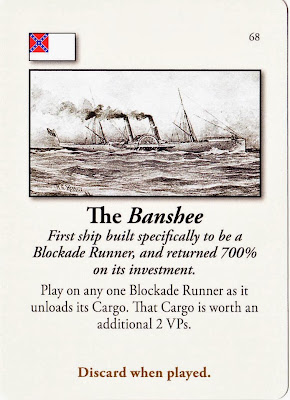A gamer who ordered and “eagerly awaits the arrival” of Rebel
Raiders on the High Seas asked if and how the game system handles the
vagaries of running the blockade, and
the abilities of Blockade Runner
captains to find “the ideal moment of tide, moon and wind to make the dash to
open sea” and to navigate the “danger of a dark shoreline” on the way back in.
Blockade Runners have
an advantage over the Union patrols, in that in the die roll to evade
interception they gain a +2 and win ties.
That means if they roll a 4 or higher, they are safe, and if they roll
less, the North still has to beat them by 3
(i.e. if a Blockade Runner
rolls a 1, the Union ship needs a 4 or better to catch her). In addition, there are some Blockade Runners
that are even more difficult to intercept, as are represented by certain
cards. Here are a few examples:
The Don (CSN Card 66)
was a particularly fast twin-screw vessel. Capable of 14 knots and drawing only six feet,
The
Don was hard to run down and could slip into coastal inlets to
hide.
Most blockade runners made a profit by their second voyage;
the CSS
Advance (CSN Card 67) made 20 such successful runs, making her one of
if not the most profitable of all of those ships that ran the Union blockade
The Banshee (CSN Card 68) was
one of the first ships built specifically to run the Union blockade. She was also one of the first commercial
vessels to build of steel. Under Joseph W.
Steele (ironic how the name and the ship match) the ship made eight successful runs, giving her owners their investment
seven times over.
The Union , however, had gunboats and
sloops that were expert at catching these ships, and many of them are in the
game. The Union can also stack ships in
the Blockade Stations off the ports, and can either roll one die for each ship
or roll a single, modified die for the stack – the bigger the stack, the better
the chance on that die. The Union
can also set up an outer blockade in the Coastal Zones; the sloops there can do
not get the modifier for a stack, but each ship does roll.
Eventually, in the game as in the war, the Blockade Runners DO get caught. There are 17 Blockade Runner counters in the
game. In the last three games I played,
we kept track, and the Union intercepted 30 to 35 of
them; which means that every Blockade Runner the South started with and built
was caught not just once but TWICE….
Many of the Blockade Runners (all but one of the above, for example) were captured and pressed into service on the blockade stations.




No comments:
Post a Comment